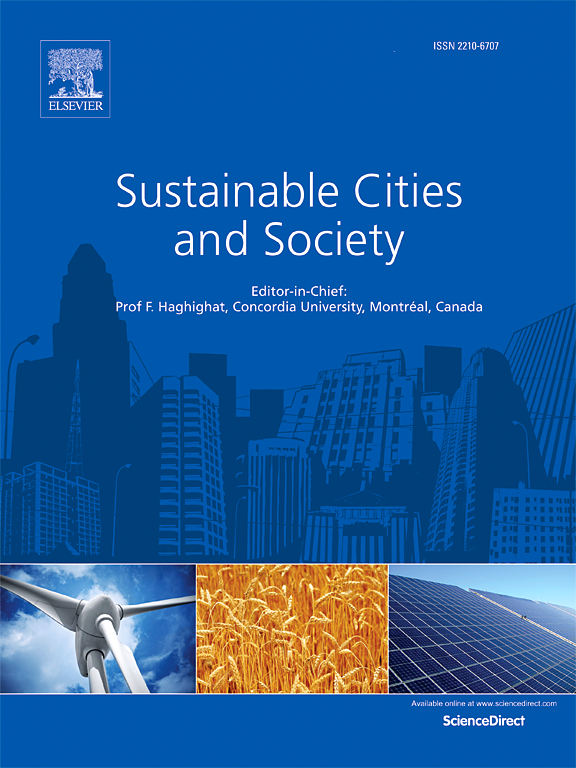Quantifying the nonlinear and interactive effects of urban form on resilience to extreme precipitation: Evidence from 192 cities of Southern China
IF 10.5
1区 工程技术
Q1 CONSTRUCTION & BUILDING TECHNOLOGY
引用次数: 0
Abstract
As extreme precipitation events become frequent due to climate change, understanding how urban form (UF) contribute to urban resilience is critical for developing effective urban resilience strategies. However, there is a lack of quantitative insights into the complex roles that various UF characteristics play in influencing urban resilience to extreme precipitation (REP). To address this issue, this study introduces a “Landscape-Materials-Service” theoretical framework. Utilizing data from 192 cities in Southern China from 2020, the XGBoost-SHAP model is employed to investigate the nonlinear and interactive effects of UF factors on REP. The results indicate that building height (), road density (), and the location quotient of living service facilities () are the dominant factors. Further local analysis shows that each feature exhibits distinct nonlinear effects, with adaptive thresholds observed in shaping resilience performance. Importantly, a positive “triangular interaction” is found among , , and . Additionally, blue, green, and gray infrastructures demonstrate both synergistic and antagonistic relationships. This research presents a novel framework for incorporating urban form into resilience planning, highlighting that urban resilience can be enhanced by balancing urban landscapes, physical infrastructure, and service facilities. These insights serve as guidance for urban planners in creating climate-resilient cities.
量化城市形态对极端降水抵御能力的非线性和互动影响:来自中国南方 192 个城市的证据
随着气候变化导致极端降水事件频繁发生,了解城市形态如何促进城市韧性对于制定有效的城市韧性战略至关重要。然而,对于各种UF特征在影响城市应对极端降水能力(REP)中的复杂作用,缺乏定量的认识。为了解决这一问题,本研究引入了“景观-材料-服务”的理论框架。利用2020年以来中国南方192个城市的数据,采用XGBoost-SHAP模型研究了UF因子对rep的非线性交互影响。结果表明,建筑高度(BH)、道路密度(RD)和生活服务设施区位商(LQ_Living)是主导因素。进一步的局部分析表明,每个特征都表现出明显的非线性效应,在形成弹性性能方面观察到自适应阈值。重要的是,在BH、RD和LQ_Living之间发现了正的“三角相互作用”。此外,蓝色、绿色和灰色基础设施表现出协同和对抗关系。本研究提出了一个将城市形态纳入弹性规划的新框架,强调城市弹性可以通过平衡城市景观、物理基础设施和服务设施来增强。这些见解为城市规划者创建气候适应型城市提供了指导。
本文章由计算机程序翻译,如有差异,请以英文原文为准。
求助全文
约1分钟内获得全文
求助全文
来源期刊

Sustainable Cities and Society
Social Sciences-Geography, Planning and Development
CiteScore
22.00
自引率
13.70%
发文量
810
审稿时长
27 days
期刊介绍:
Sustainable Cities and Society (SCS) is an international journal that focuses on fundamental and applied research to promote environmentally sustainable and socially resilient cities. The journal welcomes cross-cutting, multi-disciplinary research in various areas, including:
1. Smart cities and resilient environments;
2. Alternative/clean energy sources, energy distribution, distributed energy generation, and energy demand reduction/management;
3. Monitoring and improving air quality in built environment and cities (e.g., healthy built environment and air quality management);
4. Energy efficient, low/zero carbon, and green buildings/communities;
5. Climate change mitigation and adaptation in urban environments;
6. Green infrastructure and BMPs;
7. Environmental Footprint accounting and management;
8. Urban agriculture and forestry;
9. ICT, smart grid and intelligent infrastructure;
10. Urban design/planning, regulations, legislation, certification, economics, and policy;
11. Social aspects, impacts and resiliency of cities;
12. Behavior monitoring, analysis and change within urban communities;
13. Health monitoring and improvement;
14. Nexus issues related to sustainable cities and societies;
15. Smart city governance;
16. Decision Support Systems for trade-off and uncertainty analysis for improved management of cities and society;
17. Big data, machine learning, and artificial intelligence applications and case studies;
18. Critical infrastructure protection, including security, privacy, forensics, and reliability issues of cyber-physical systems.
19. Water footprint reduction and urban water distribution, harvesting, treatment, reuse and management;
20. Waste reduction and recycling;
21. Wastewater collection, treatment and recycling;
22. Smart, clean and healthy transportation systems and infrastructure;
 求助内容:
求助内容: 应助结果提醒方式:
应助结果提醒方式:


